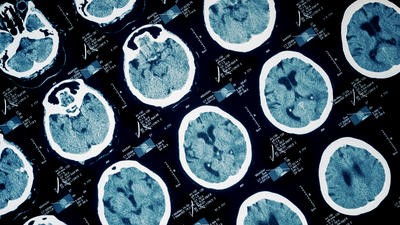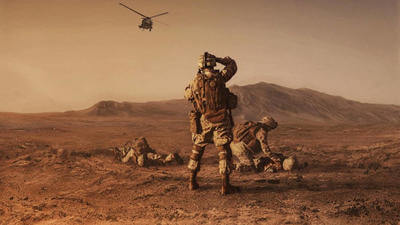Transporting patients after a decompressive craniectomy

Dr Thomas Buchsein of FAI Flight Ambulance (FAI) in Germany spoke to AirMed&Rescue about the challenges of transporting patients after a decompressive craniectomy
Case report
On a sunny day in late spring 2018, a small group of Scandinavian holidaymakers were on a mountain bike tour in Monte Conero, Provincia Ancona, Italy. On a scenic coastal road, one of their party – a lady in her late forties – lost control of her bike on the sloping road when the front wheel skidded sideways on a patch of gravel.
She hit the ground hard, headfirst, and her loose-fitting helmet was knocked off her head. She lost consciousness instantly.
When rescue services arrived at the scene – a rather remote site – 35 minutes later, the medics found her unresponsive with one fixed and dilated pupil. They established IV access, intubated her, and rushed her to the Trauma Center of Ospedali Riuniti di Ancona.
Urgent radiological imaging identified a large left frontoparietal subdural haemorrhage with midline-shift to the right and compression of the left lateral ventricle. An immediate burr hole evacuation of the haematoma was performed.
Two days later, the patient developed a significant re-bleed with increasing mass effect in the left cerebral hemisphere, and so a craniotomy was performed to evacuate the blood once again. Intraoperatively, the cerebral tissue appeared to be under considerable pressure and began to prolapse into the craniotomy opening. At this point, the decision was taken to proceed with a more extensive opening of the cranial bone by performing a decompressive craniectomy.

The operation went well, and the resected bone flap (slightly larger than the average size of a palm) was deep-frozen and stored in the hospital’s bone bank.
An intracerebral pressure probe showed satisfactory results that were close to the norm. The further clinical course was characterised by a slow but steady neurological recovery, and three weeks later, while still intubated and ventilated, the patient displayed increased alertness, seemed to recognise familiar voices, reacted when spoken to and, after a few more days, began to respond to and follow simple commands.
However, a significant residual motor weakness of the patient’s right side was observed.
The process of weaning the patient off mechanical ventilation was progressing satisfactorily and a nosocomial airway infection seemed to be responding well to antibiotics.
The assistance company’s perspective
At this point, it became increasingly clear that the treatment focus would soon shift to intensive neurological rehabilitation; a lengthy process that would be best carried out near the patient’s home, close to her family and friends. It was also unlikely that the patient would be fit to fly on a commercial scheduled flight any time soon, so the assistance company contacted FAI requesting a quote for an air ambulance repatriation to Sweden.

Bone flap storage
Depending on the individual situation, it is often decided to keep the resected bone flap for later replantation. For this purpose, it is usually preserved deep-frozen in a ‘bone bank’ (several studies document various methods of bone cryopreservation and storage practices in neurosurgical centres throughout the world, with temperatures between -35°C to -84°C in liquid nitrogen cooling systems, and cryoprotectant solutions vary likewise).
An alternative solution is to sew the flap into the subcutaneous tissue of the abdominal wall, where its viability is maintained by the body. Advantages of storing the flap in the abdominal wall include sterility, continued nourishment and simple transport inside the patient’s body. A disadvantage is the not-so-rare phenomenon whereby weeks – or sometimes months – later, neurosurgeons, when intending to retrieve the bone flap from the abdomen to close the skull, find it in a partially-resorbed state.
Decompressive craniectomy
A neurosurgical procedure in which a part of the skull is removed to allow the brain to expand, thus relieving intracranial pressure. The technique is used in patients with traumatic brain injury or severe stroke, where the elevated pressure within the cranial vault can no longer be managed with conservative means (such as osmotherapy with Mannitol IV or elevation of the upper body by approximately 40° etc.) and cerebral perfusion becomes difficult to maintain.
The air ambulance provider’s perspective
With 17 such flights in 2018, and similar numbers in previous years, FAI is experienced in repatriating post-craniectomy patients. And we have seen it all: ward nurses running after us, unexpectedly handing over a Styrofoam box with dry ice fog pouring out, and proudly announcing: “Our doc says you need this, it’s the patient’s brain – oops, sorry, the skull! Oh no, not the whole thing, only parts of it!” We’ve had clients failing to inform us at all that such a procedure had been done, as well as desperate pleas from family members urging us not to leave any part of the patient behind.
Replantation
A craniectomy defect is typically reclosed between six and 20 weeks after removal. Frequently, the patient’s own cryopreserved or abdominal wall-stored bone flap will be replanted, but also, quite often neurosurgeons choose artificial materials to replace the bone flap. Typically, this either uses the natural bone fragment as a mould for an artificial cover plate, or else computer-aided design (CAD) is utilised for skull reconstruction with titanium implants.
For legal reasons, very few neurosurgeons accept bone flaps for replantation that have not been stored according to their own protocols and supervision in their own hospital – even less so with an air ambulance flight in between!

Communication is key
Decompressive craniectomy flights are one of the medical situations where the success or failure of the whole process depends on the quality of communication
Decompressive craniectomy flights are one of the medical situations where the success or failure of the whole process depends on the quality of communicationbetween the client (the assistance company) and the provider (the air ambulance operator). FAI has distributed an information leaflet to all our clients that outlines some key information to be mindful of:
- The logistics and effort involved in taking liquid nitrogen containers onboard the aircraft in line with Dangerous Goods Regulations is out of balance with the ultimate benefit to the patient. While it can be achieved, it is not desirable.
- We strongly encourage direct communication between all neurosurgeons at the sending and receiving facilities in order to clarify the conditions in which replantation of the bone flap should be considered and, indeed, whether this procedure is necessary.
- We do offer to take the bone flap on board, though not deep-frozen for a possible replantation; it must be sufficiently cooled (at a maximum temperature of 4°C) so that it can serve as a mould for an artificial replacement of the bone defect.
- We encourage the facility to provide a customised ‘helmet’ for the patient to protect them from any outside impact. Following a craniectomy, large parts of the brain are only covered by soft tissue, and are thus exposed to external impacts. To prevent further injury, patients need a specialised helmet that has been individually adapted to provide maximum protection while ensuring no pressure is applied to the head itself.
The bottom line
The three most important considerations when planning and executing air ambulance transport missions for these patients are:
- Communication: Directly between the neurosurgeon of the sending and the receiving facility, as explained above.
- Equipment: The provision of a customised ‘helmet’ for the patient to protect them from any outside impact.
- Planning: Missions must be planned well in advance to allow for the appropriate amount of time required to achieve the above two objectives – patients are usually in relatively stable condition and so there is no room for poor planning and rushed timing.
Literature
X. Huang, L. Wen, ‘Technical Considerations in Decompressive Craniectomy in the Treatment of Traumatic Brain Injury’, International Journal of Medical Sciences, 2010; 7(6):385-390 © Ivyspring International Publisher.
D. J. Cooper, et al., ‘Decompressive Craniectomy in Diffuse Traumatic Brain Injury’, The New England Journal of Medicine. Band 364, Nr 16, April 2011, S. 1493–1502, ISSN 1533-4406. doi:10.1056/NEJMoa1102077. PMID 21434843.
This article originally appeared in the November 2019 issue of AirMed&Rescue

November 2019
Issue
The price is right – or is it? The cost of insuring medical flights
Reality in a virtual world - The evolution of virtual and augmented reality
A dying breed - Pilot retention in the air medical sector
Dromaders from Athens - Greek fire-fighting assets
Mind your head - Decompressive craniectomy flights
Interview: Matthew Napiltonia, Global Rescue
Provider Profile: Med-Trans Corp
Case Study: MEDEVAC.Flights describes a difficult repatriation from China


